Holocoust
Download as pptx, pdf0 likes292 views
history and religious intolerance
1 of 12
Download to read offline
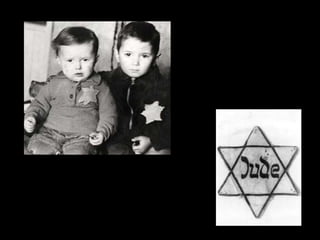


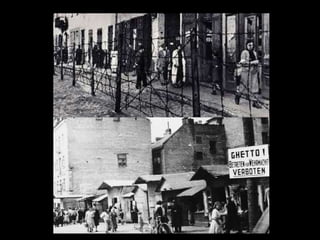
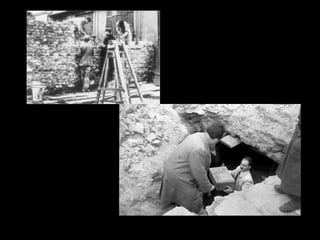
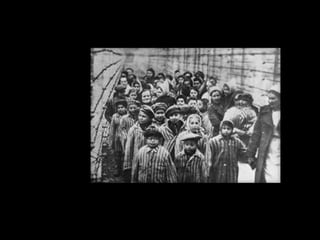
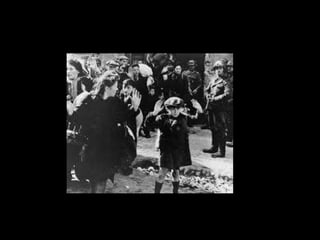
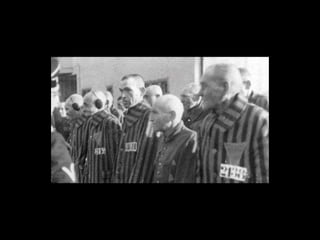
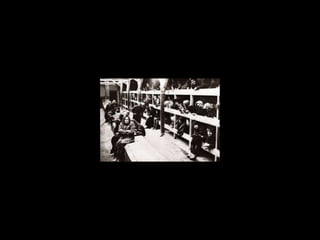

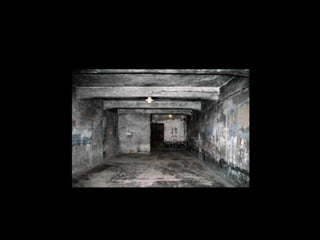
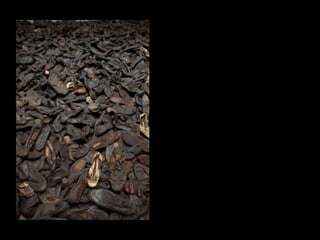
Ad
Recommended
The Battle of Culloden
The Battle of CullodenANAHANDERSON
╠²
The document outlines roles and topics for student groups to research about the Battle of Culloden for presentations. It assigns each group a topic area of the battle to research over several weeks and present their findings to the class using PowerPoint. The document also defines group roles like Resources Manager, Recorder, Encourager, and Timer to help with the cooperative work.Week 6 - The Other Treaties
Week 6 - The Other TreatiesJason Fowler
╠²
The document discusses the treaties that ended World War 1 besides the Treaty of Versailles. It notes there was disagreement among the allies, loss of self-determination for ethnic groups, and the treaties separated or combined multiple ethnic groups into countries. Students will work in groups of two to write a newspaper headline and article in present tense about the treaty that affected their assigned country, including the date. The criteria for marking the newspaper assignments is provided. Maps show Hungary and Turkey before and after the treaties of Trianon and Sevres respectively, and Mustafa Kemal Ataturk led Turkey after the Treaty of Lausanne replaced the Treaty of Sevres.Origins of scotland_and_nova_scotia_08242014_jga
Origins of scotland_and_nova_scotia_08242014_jgaJohn Gillis
╠²
Scotland's history spans Roman, Pictish, Gaelic, and English influences. In the 6th century, Gaelic-speaking Scots founded the kingdom of D├Īl Riata in western Scotland and Ireland, though some dispute this origin story. In the 9th century, the kingdoms of the Picts and Scots merged to form the kingdom of Alba. Catholicism was an important religion for centuries, until the Scottish Reformation in 1560 established the Presbyterian Church of Scotland. The Jacobite risings in the 18th century sought to restore the Catholic Stuarts to the throne but failed after the Battle of Culloden. Highland clearances then displaced many clans. Many Scots emigrated to placesStages of the Holocaust
Stages of the HolocaustDan McDowell
╠²
The document outlines the history of anti-Semitism in Europe leading up to and during the Holocaust. It discusses how Jews were historically discriminated against and scapegoated. In early 20th century Germany, Hitler blamed Jews for Germany's loss in WWI and pushed the ideology of Aryan racial supremacy. This led to the boycott of Jewish businesses in 1933 and the Nuremberg Laws stripping Jews of rights in 1935. Kristallnacht organized violence against Jews in 1938. During 1939-1945, Jews were isolated in ghettos and millions were deported to camps, where many were killed in gas chambers or by forced labor, until the camps were liberated by Allied forces by 1945.Lsn31 newspaperproject
Lsn31 newspaperprojectMadisen
╠²
World War 2 was one of the most dangerous wars ever, killing over 7.4 million people between 1939 and 1945 mainly across Europe, East Asia, and islands in the Pacific. It started after Germany lost WWI and fell into depression, electing Hitler who began illegally building up weapons and breaking treaties. The League of Nations failed to stop the war due to lacking power and quick response capabilities. During WWII, reform was desperately needed to change societies' hatred and fear, which could have prevented a worse outcome without changes.The 4 "C's" of Success
The 4 "C's" of SuccessRobert Rodenbaugh
╠²
The document provides an overview of Jane Grote Abell's growth strategy as the chairman and owner of a family-owned franchise business. Some of the key lessons learned include focusing on real estate and drive-thru locations, establishing efficient processes and systems, developing employees through training programs, and growing in a way that maintains brand passion among employees. The document also discusses balancing short-term and long-term goals when deciding between private and public ownership, as well as the importance of upholding core values and principles as a business scales.World War 2 (WWII)
World War 2 (WWII)wtidwell
╠²
World War 2 pulled the US out of the Great Depression as the economy shifted to focus on wartime production. Various government agencies were established to direct industries to make military goods and manage supply shortages and price controls. Factories converted operations to produce airplanes, ships, weapons and ammunition. By 1945 the US had produced over 300,000 airplanes and other military equipment, becoming known as the "Arsenal of Democracy". Financing the war required increased taxes and sales of war bonds. Over 14 million women joined the workforce during the war to replace men serving in the military.The Four Stages of the Holocaust
The Four Stages of the HolocaustMr. Finnie
╠²
The document outlines the four stages of the Holocaust: defining Jews as 'other', removing their rights, concentration in ghettos, and the final solution for mass extermination. It details the systemic antisemitism propagated by the Nazi regime, including the establishment of oppressive laws, the formation of ghettos, and the horrific methods employed in extermination camps like Auschwitz. Ultimately, the Nazi atrocities resulted in the deaths of approximately six million Jews, starkly highlighting the horrors of this historical period.Holocaust Power Point
Holocaust Power Pointatkinsonms
╠²
The document discusses the Holocaust and examples of genocide throughout history. It defines genocide as the systematic destruction of a racial, religious, political or cultural group. It then lists some key elements that led to the Holocaust, including totalitarianism, German nationalism, a history of antisemitism, defeat in WWI, and Hitler's belief in racial supremacy. The document also provides details about aspects of the Holocaust such as ghettos, concentration camps, means of transportation, gas chambers, and crematoriums. It concludes by briefly mentioning some examples of other genocides including against Armenians, in the Soviet Union, Cambodia, Rwanda, Yugoslavia, and Darfur.U5. imperialism & WW1
U5. imperialism & WW1Roc├Ło Bautista
╠²
The document provides background information on imperialism and its role in leading to World War 1. It discusses the rise of nationalism in Europe in the 19th century which created new countries like Germany and Italy. It also examines the Scramble for Africa during this period as European powers colonized the continent. Finally, it outlines the alliance systems and tensions between European powers in the early 20th century prior to the outbreak of World War 1, noting this conflict was sparked by the assassination of Archduke Franz Ferdinand.Anne Frank
Anne FrankCorey Topf
╠²
Anne Frank was born in Germany in 1929 to a Jewish family. When the Nazis came to power, the Franks went into hiding in a secret annex behind her father's office to escape persecution. Anne received a diary as a gift for her 13th birthday, which she used to record her experiences while in hiding. In August 1944, the annex was raided and the Franks were arrested and deported to concentration camps, where Anne and her sister eventually died of typhus at Bergen-Belsen. After the war, Anne's father Otto had her diary published, which has since become one of the most widely read books about the Holocaust.Causes WWII
Causes WWIImultimedialearningllc
╠²
The document lists and briefly describes the major causes of World War 2, including the Treaty of Versailles, rise of fascism in Italy under Mussolini, rise of Hitler and the Nazi party in Germany, the worldwide Great Depression, Japanese expansionism, anti-communism, appeasement of Hitler, militarism, nationalism, and American isolationism in the 1930s. It also provides maps showing the key theaters of war and lists Hitler's Axis partners versus the Allied powers in WWII.World war 2
World war 2Ferit G├╝ner
╠²
World War 2 was caused by several interrelated factors including unsatisfactory peace treaties after WWI, the rise of totalitarian regimes in Germany, Italy and Japan, and the economic turmoil of the Great Depression. The peace treaties imposed harsh conditions on Germany which led to resentment, while totalitarian dictators like Hitler rose to power on nationalist platforms and began aggressively expanding territory. Germany annexed Austria and parts of Czechoslovakia, signed alliances with Italy and Japan, and violated disarmament clauses, making war seem inevitable. In September 1939, Germany invaded Poland, marking the official start of World War 2.U6. interwar years & ww2
U6. interwar years & ww2Roc├Ło Bautista
╠²
The document provides background information on the interwar period and World War 2. It discusses the Russian Revolution and establishment of the USSR. The Bolshevik revolution established a communist government led by Lenin that nationalized industries and abolished private property. A civil war ensued from 1918 to 1921 which the Red Army won, consolidating Bolshevik rule. Stalin later established a totalitarian dictatorship through policies like collectivization, industrialization and the Gulag system. The document also covers the rise of fascism in Germany under Hitler and Italy under Mussolini as responses to economic crisis and a rejection of democracy.Spending Review 2025 Event Presentation RF
Spending Review 2025 Event Presentation RFResolutionFoundation
╠²
The GovernmentŌĆÖs fiscal events have had a shaky start so far. The Autumn Budget unveiled ┬Ż41 billion of tax rises by 2029-30, while the Spring Statement was dominated by controversial welfare reform that will hit poorer families the hardest. The upcoming Spending Review provides a fresh opportunity to focus on growth and living standards, as it sets out the details of over ┬Ż40 billion additional annual day-to-day public service spending, and over ┬Ż100 billion worth of infrastructure funding. But with Britain facing the strong headwinds of global economic turbulence and strained public services, will it be third time lucky for the Chancellor?
Has the Government boosted public services across the board, or has the NHS taken the lionŌĆÖs share of the cash? Has public investment centred on repairing BritainŌĆÖs fraying social infrastructure ŌĆō its schools, hospitals and housing stock - or building new economic and energy infrastructure? Have limited resources been effectively prioritised to support growth and improve living standards? And how might the Spending Review shape the upcoming Budget this Autumn?
Air India Plane Crash: Tragedy Strikes Near Ahmedabad
Air India Plane Crash: Tragedy Strikes Near AhmedabadNew India Abroad
╠²
The Air India Plane Crash on June 12, 2025, shocked the nation and the global Indian community. A Boeing 787-8 Dreamliner, carrying 242 passengers and crew, crashed shortly after taking off from Ahmedabad Airport, on route to London. The aircraft struck a hostel near B.J. Medical College, causing fatalities both onboard and on the ground. Investigations are ongoing, focusing on possible engine failure. One Indian-origin British passenger survived. Families worldwide are mourning this tragic Air India Plane Crash, and New India Abroad continues to provide in-depth coverage on the disaster and its far-reaching impact.PRESS-RELEASE-WIFE-3.pdfKen Ofori-Atta undergoes successful prostate cancer s...
PRESS-RELEASE-WIFE-3.pdfKen Ofori-Atta undergoes successful prostate cancer s...businessweekghana
╠²
Ken Ofori-Atta undergoes successful prostate cancer surgery ŌĆō Wife discloses12062025_First India Newspaper Jaipur.pdf
12062025_First India Newspaper Jaipur.pdfFIRST INDIA
╠²
Find Latest India News and Breaking News these days from India on Politics, Business, Entertainment, Technology, Sports, Lifestyle and Coronavirus News in India and the world over that you can't miss. For real time update Visit our social media handle. Read First India NewsPaper in your morning replace. Visit First India.
CLICK:- https://firstindia.co.in/
#First_India_NewsPaperEDSA Revolution and Democracy - the Youth and Students in Focus [uploadable]....
EDSA Revolution and Democracy - the Youth and Students in Focus [uploadable]....ssuser0e98111
╠²
This presentation talks about the EDSA Revolution and Democracy in general and its context with the youth.Gatwick AG About A Company Shut Down by UK Courts Still Sells Offshore Servic...
Gatwick AG About A Company Shut Down by UK Courts Still Sells Offshore Servic...nathaniel leonard
╠²
Gatwick AG was dissolved by British authorities in 2023. Its website remains active. And former clients say theyŌĆÖve been misled and defrauded.
13062025_First India Newspaper Jaipur.pdf
13062025_First India Newspaper Jaipur.pdfFIRST INDIA
╠²
Find Latest India News and Breaking News these days from India on Politics, Business, Entertainment, Technology, Sports, Lifestyle and Coronavirus News in India and the world over that you can't miss. For real time update Visit our social media handle. Read First India NewsPaper in your morning replace. Visit First India.
CLICK:- https://firstindia.co.in/
#First_India_NewsPaperAbdulwahed Abdulazeez- the legacy of a kind leader
Abdulwahed Abdulazeez- the legacy of a kind leadersameerlicht19
╠²
Some key moments captured during the tenure of Abdulwahed Abdulazeez as the 44th Executive President of ASSON ABU ZariaPathos Communications When Reputation Management Becomes Reputation Destructi...
Pathos Communications When Reputation Management Becomes Reputation Destructi...nathaniel leonard
╠²
A recent letter from UK-based firm Pathos Communications: When Reputation Management Becomes Reputation DestructionOneworld Energy USA LLC Fraud CEO Mike Minor.pptx
Oneworld Energy USA LLC Fraud CEO Mike Minor.pptxnathaniel leonard
╠²
Oneworld Energy USA LLC CEO Accused in Multi-Jurisdictional Fraud: A Closer Look at Mike MinorMore Related Content
Viewers also liked (7)
The Four Stages of the Holocaust
The Four Stages of the HolocaustMr. Finnie
╠²
The document outlines the four stages of the Holocaust: defining Jews as 'other', removing their rights, concentration in ghettos, and the final solution for mass extermination. It details the systemic antisemitism propagated by the Nazi regime, including the establishment of oppressive laws, the formation of ghettos, and the horrific methods employed in extermination camps like Auschwitz. Ultimately, the Nazi atrocities resulted in the deaths of approximately six million Jews, starkly highlighting the horrors of this historical period.Holocaust Power Point
Holocaust Power Pointatkinsonms
╠²
The document discusses the Holocaust and examples of genocide throughout history. It defines genocide as the systematic destruction of a racial, religious, political or cultural group. It then lists some key elements that led to the Holocaust, including totalitarianism, German nationalism, a history of antisemitism, defeat in WWI, and Hitler's belief in racial supremacy. The document also provides details about aspects of the Holocaust such as ghettos, concentration camps, means of transportation, gas chambers, and crematoriums. It concludes by briefly mentioning some examples of other genocides including against Armenians, in the Soviet Union, Cambodia, Rwanda, Yugoslavia, and Darfur.U5. imperialism & WW1
U5. imperialism & WW1Roc├Ło Bautista
╠²
The document provides background information on imperialism and its role in leading to World War 1. It discusses the rise of nationalism in Europe in the 19th century which created new countries like Germany and Italy. It also examines the Scramble for Africa during this period as European powers colonized the continent. Finally, it outlines the alliance systems and tensions between European powers in the early 20th century prior to the outbreak of World War 1, noting this conflict was sparked by the assassination of Archduke Franz Ferdinand.Anne Frank
Anne FrankCorey Topf
╠²
Anne Frank was born in Germany in 1929 to a Jewish family. When the Nazis came to power, the Franks went into hiding in a secret annex behind her father's office to escape persecution. Anne received a diary as a gift for her 13th birthday, which she used to record her experiences while in hiding. In August 1944, the annex was raided and the Franks were arrested and deported to concentration camps, where Anne and her sister eventually died of typhus at Bergen-Belsen. After the war, Anne's father Otto had her diary published, which has since become one of the most widely read books about the Holocaust.Causes WWII
Causes WWIImultimedialearningllc
╠²
The document lists and briefly describes the major causes of World War 2, including the Treaty of Versailles, rise of fascism in Italy under Mussolini, rise of Hitler and the Nazi party in Germany, the worldwide Great Depression, Japanese expansionism, anti-communism, appeasement of Hitler, militarism, nationalism, and American isolationism in the 1930s. It also provides maps showing the key theaters of war and lists Hitler's Axis partners versus the Allied powers in WWII.World war 2
World war 2Ferit G├╝ner
╠²
World War 2 was caused by several interrelated factors including unsatisfactory peace treaties after WWI, the rise of totalitarian regimes in Germany, Italy and Japan, and the economic turmoil of the Great Depression. The peace treaties imposed harsh conditions on Germany which led to resentment, while totalitarian dictators like Hitler rose to power on nationalist platforms and began aggressively expanding territory. Germany annexed Austria and parts of Czechoslovakia, signed alliances with Italy and Japan, and violated disarmament clauses, making war seem inevitable. In September 1939, Germany invaded Poland, marking the official start of World War 2.U6. interwar years & ww2
U6. interwar years & ww2Roc├Ło Bautista
╠²
The document provides background information on the interwar period and World War 2. It discusses the Russian Revolution and establishment of the USSR. The Bolshevik revolution established a communist government led by Lenin that nationalized industries and abolished private property. A civil war ensued from 1918 to 1921 which the Red Army won, consolidating Bolshevik rule. Stalin later established a totalitarian dictatorship through policies like collectivization, industrialization and the Gulag system. The document also covers the rise of fascism in Germany under Hitler and Italy under Mussolini as responses to economic crisis and a rejection of democracy.Recently uploaded (12)
Spending Review 2025 Event Presentation RF
Spending Review 2025 Event Presentation RFResolutionFoundation
╠²
The GovernmentŌĆÖs fiscal events have had a shaky start so far. The Autumn Budget unveiled ┬Ż41 billion of tax rises by 2029-30, while the Spring Statement was dominated by controversial welfare reform that will hit poorer families the hardest. The upcoming Spending Review provides a fresh opportunity to focus on growth and living standards, as it sets out the details of over ┬Ż40 billion additional annual day-to-day public service spending, and over ┬Ż100 billion worth of infrastructure funding. But with Britain facing the strong headwinds of global economic turbulence and strained public services, will it be third time lucky for the Chancellor?
Has the Government boosted public services across the board, or has the NHS taken the lionŌĆÖs share of the cash? Has public investment centred on repairing BritainŌĆÖs fraying social infrastructure ŌĆō its schools, hospitals and housing stock - or building new economic and energy infrastructure? Have limited resources been effectively prioritised to support growth and improve living standards? And how might the Spending Review shape the upcoming Budget this Autumn?
Air India Plane Crash: Tragedy Strikes Near Ahmedabad
Air India Plane Crash: Tragedy Strikes Near AhmedabadNew India Abroad
╠²
The Air India Plane Crash on June 12, 2025, shocked the nation and the global Indian community. A Boeing 787-8 Dreamliner, carrying 242 passengers and crew, crashed shortly after taking off from Ahmedabad Airport, on route to London. The aircraft struck a hostel near B.J. Medical College, causing fatalities both onboard and on the ground. Investigations are ongoing, focusing on possible engine failure. One Indian-origin British passenger survived. Families worldwide are mourning this tragic Air India Plane Crash, and New India Abroad continues to provide in-depth coverage on the disaster and its far-reaching impact.PRESS-RELEASE-WIFE-3.pdfKen Ofori-Atta undergoes successful prostate cancer s...
PRESS-RELEASE-WIFE-3.pdfKen Ofori-Atta undergoes successful prostate cancer s...businessweekghana
╠²
Ken Ofori-Atta undergoes successful prostate cancer surgery ŌĆō Wife discloses12062025_First India Newspaper Jaipur.pdf
12062025_First India Newspaper Jaipur.pdfFIRST INDIA
╠²
Find Latest India News and Breaking News these days from India on Politics, Business, Entertainment, Technology, Sports, Lifestyle and Coronavirus News in India and the world over that you can't miss. For real time update Visit our social media handle. Read First India NewsPaper in your morning replace. Visit First India.
CLICK:- https://firstindia.co.in/
#First_India_NewsPaperEDSA Revolution and Democracy - the Youth and Students in Focus [uploadable]....
EDSA Revolution and Democracy - the Youth and Students in Focus [uploadable]....ssuser0e98111
╠²
This presentation talks about the EDSA Revolution and Democracy in general and its context with the youth.Gatwick AG About A Company Shut Down by UK Courts Still Sells Offshore Servic...
Gatwick AG About A Company Shut Down by UK Courts Still Sells Offshore Servic...nathaniel leonard
╠²
Gatwick AG was dissolved by British authorities in 2023. Its website remains active. And former clients say theyŌĆÖve been misled and defrauded.
13062025_First India Newspaper Jaipur.pdf
13062025_First India Newspaper Jaipur.pdfFIRST INDIA
╠²
Find Latest India News and Breaking News these days from India on Politics, Business, Entertainment, Technology, Sports, Lifestyle and Coronavirus News in India and the world over that you can't miss. For real time update Visit our social media handle. Read First India NewsPaper in your morning replace. Visit First India.
CLICK:- https://firstindia.co.in/
#First_India_NewsPaperAbdulwahed Abdulazeez- the legacy of a kind leader
Abdulwahed Abdulazeez- the legacy of a kind leadersameerlicht19
╠²
Some key moments captured during the tenure of Abdulwahed Abdulazeez as the 44th Executive President of ASSON ABU ZariaPathos Communications When Reputation Management Becomes Reputation Destructi...
Pathos Communications When Reputation Management Becomes Reputation Destructi...nathaniel leonard
╠²
A recent letter from UK-based firm Pathos Communications: When Reputation Management Becomes Reputation DestructionOneworld Energy USA LLC Fraud CEO Mike Minor.pptx
Oneworld Energy USA LLC Fraud CEO Mike Minor.pptxnathaniel leonard
╠²
Oneworld Energy USA LLC CEO Accused in Multi-Jurisdictional Fraud: A Closer Look at Mike MinorAd
